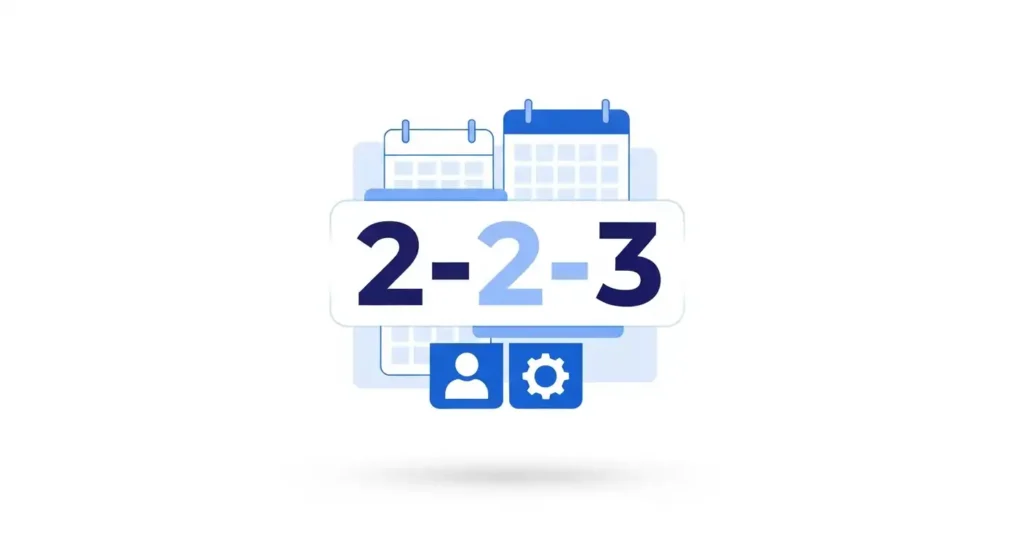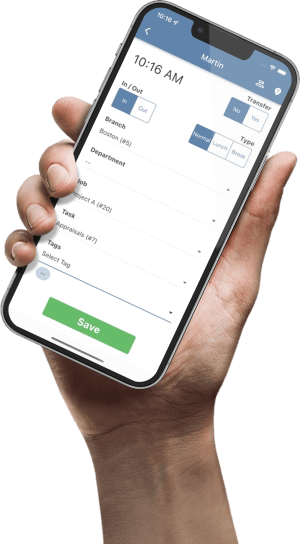Free 2-2-3 Employee Schedule Generator

2-2-3 Employee Schedule Generator
Quick Guide to the 2-2-3 Shift Schedule
The 2-2-3 schedule is a sophisticated rotational system designed for the specific demands of continuous, 24/7 operations. Below is a detailed guide to its mechanics, strategic implementation, and operational best practices.
Section 1: Anatomy of the 2-2-3 Schedule
The successful implementation of any complex operational system begins with a granular understanding of its mechanics. The 2-2-3 shift schedule, while often referred to by a simple name, is a sophisticated rotational system designed for the specific demands of continuous, 24/7 operations. Its structure is a carefully balanced equation of work periods, rest days, and team coordination. Misinterpreting its foundational elements can lead to significant logistical and human resource challenges. Therefore, a precise deconstruction of its components is the essential first step for any organization considering its adoption.
1.1 Deconstructing the Rotation: The Core 14-Day Cycle
The 2-2-3 schedule is fundamentally a rotating shift pattern built upon a two-week (14-day) cycle. The name "2-2-3" is a direct reference to the sequence of work and rest days for a single employee or team within the first week of this cycle. The pattern is predicated on the use of 12-hour shifts, which allows a 24-hour day to be covered by exactly two shifts—typically a day shift (e.g., 6:00 AM to 6:00 PM) and a night shift (e.g., 6:00 PM to 6:00 AM).
The 14-day cycle for a single team unfolds as follows:
- Week 1: The team works for two consecutive days, followed by two consecutive days off, and then works for three consecutive days. This week involves five 12-hour shifts.
- Week 2: The pattern inverts. The team has two consecutive days off, followed by two consecutive work days, and concludes with three consecutive days off. This week involves only two 12-hour shifts.
This structure results in employees working approximately 15 days per month and around 180 days per year, a significant reduction from the roughly 260 workdays in a traditional Monday-to-Friday, 8-hour/day schedule. While the number of workdays is fewer, the total annual hours are comparable due to the longer shift duration. A highly valued feature of this pattern is the built-in three-day weekend that occurs every other week, a significant factor in promoting work-life balance.
1.2 The Four-Team System: Engineering Seamless 24/7 Coverage
To achieve uninterrupted 24/7 coverage, the 2-2-3 schedule requires the workforce to be organized into four distinct teams. While one team follows the 14-day pattern described above, the other three teams follow the same pattern but on an offset or staggered basis. This interleaving of schedules is the mechanism that ensures every day shift and every night shift is staffed, 365 days a year.
The complete operational cycle for the system is not 14 days, but 28 days (four weeks). This longer cycle accommodates the rotation between day and night shifts, which is a critical component for ensuring fairness. A common implementation involves a team working the day-shift version of the 14-day pattern for two weeks, and then switching to the night-shift version for the subsequent two weeks. This methodical rotation ensures that the burden of working overnight—often considered less desirable and more physiologically taxing—is distributed equitably among all four teams, which can prevent disputes over shift assignments.
The simple "2-2-3" name, therefore, can be misleading. It describes only a fraction of the total system. A manager's mental model should not be of a simple weekly pattern, but of a fully integrated, 28-day, four-team rotational machine.
1.3 Visualizing the Schedule: A Master 28-Day Rotation Calendar
To translate the abstract principles of the schedule into a practical operational tool, a master calendar is indispensable. The following table illustrates a complete 28-day cycle for a standard four-team system, providing a clear visual representation of how continuous coverage is maintained.
(Note: D = 12-Hour Day Shift, N = 12-Hour Night Shift, O = Off Day)
| Team | Wk 1: M-Su | Wk 2: M-Su | Wk 3: M-Su | Wk 4: M-Su |
|---|---|---|---|---|
| A | D, D, O, O, D, D, D | O, O, D, D, O, O, O | N, N, O, O, N, N, N | O, O, N, N, O, O, O |
| B | N, N, O, O, N, N, N | O, O, N, N, O, O, O | D, D, O, O, D, D, D | O, O, D, D, O, O, O |
| C | O, O, N, N, O, O, O | D, D, O, O, D, D, D | O, O, D, D, O, O, O | N, N, O, O, N, N, N |
| D | O, O, D, D, O, O, O | N, N, O, O, N, N, N | O, O, N, N, O, O, O | D, D, O, O, D, D, D |
This calendar demonstrates the system's balance. On any given day, two teams are working (one on days, one on nights) and two teams are off, ensuring both coverage and adequate rest periods.
1.4 Nomenclature Clarified: "Panama," "Pitman," and Other Aliases
In industry literature and operational discussions, the 2-2-3 schedule is known by several names, which can be a source of confusion. The terms "Panama Schedule" and "Pitman Schedule" are the most common aliases and are frequently used interchangeably with "2-2-3" to describe the same core 14-day rotational pattern. The "Panama" moniker is widely believed to have originated from the schedule's use in managing the continuous operational needs of the Panama Canal. Similarly, the pattern is sometimes referred to as a "2-3-2" schedule, which describes the same sequence of work and rest days within the two-week cycle, just starting from a different point.
While these terms often refer to the same structure, some sources introduce subtle but important distinctions. For instance, the Pitman schedule is sometimes described as a variant that can be implemented as either a rotating system (where teams alternate between day and night shifts) or a fixed system (where specific teams are permanently assigned to either day or night shifts). The Panama schedule, in contrast, almost universally implies rotation between day and night shifts.
Section 2: Strategic Assessment: Is the 2-2-3 Schedule Right for Your Organization?
Moving beyond the mechanics, a strategic evaluation is necessary to determine if the 2-2-3 schedule aligns with an organization's operational goals, financial constraints, and workforce culture. This assessment requires a balanced analysis of its powerful advantages against its significant human and logistical costs.
2.1 The Business Case: Advantages for Employers
The primary driver for adopting a 2-2-3 schedule is the ability to maintain continuous, uninterrupted operations. For industries where downtime is exceptionally costly or service delivery is critical, this model provides a robust framework for 24/7/365 coverage.
Beyond simple coverage, the schedule offers distinct efficiency gains. An operation based on 12-hour shifts has only two shift handovers per day, compared to three in a traditional 8-hour shift system. This reduction in transition points minimizes the opportunities for communication errors, incomplete information transfer, and operational disruptions that can occur during shift changes.
From a planning perspective, the schedule's highly structured and repetitive nature provides exceptional predictability. Management can forecast labor coverage and costs months or even years in advance, simplifying long-term strategic planning.
2.2 The Human Factor: Impact on Employees
The 2-2-3 schedule presents a duality of outcomes for employees, offering substantial benefits in time off while simultaneously posing significant health and lifestyle challenges.
Positive Impacts (The "Work-Life Balance" Argument)
The most frequently cited benefit for employees is the significant amount of time off. With more consecutive rest days, including a three-day weekend every other week, employees have large, predictable blocks of time for family, appointments, and personal pursuits. This structure can lead to a perceived improvement in work-life balance and higher employee satisfaction.
Negative Impacts (The Health and Fatigue Reality)
The advantages of extended time off are directly counterbalanced by the intensity of the work periods. The foundation of the schedule—the 12-hour shift—is inherently taxing. Extensive research has linked long work shifts, particularly when combined with night work, to a range of negative health outcomes, including increased stress, disrupted sleep patterns, and a higher risk of chronic health issues.
This creates a "work-life balance" paradox: the schedule provides more days off, but many of those days may be required for physiological recovery from the demanding work shifts rather than for leisure.
2.3 A Balanced Scorecard: Consolidated Pros and Cons
To facilitate a clear strategic decision, the following table consolidates the advantages and disadvantages of the 2-2-3 schedule.
| Category | Advantages | Disadvantages |
|---|---|---|
| For Employers |
Guaranteed 24/7/365 Coverage. Increased Efficiency (fewer handovers). Predictable Scheduling. Fair Shift Distribution (if rotating). |
Built-in Overtime Costs (e.g., under FLSA). Operational Brittleness (hard to cover absences). Increased Safety Risk (fatigue-related). Potential for Higher Employee Turnover. |
| For Employees |
Extended Time Off (more days off/year). Frequent 3-day weekends. Predictable Schedule. Fewer Commutes per week. |
12-Hour Shift Fatigue (physical/mental drain). Circadian Rhythm Disruption (day/night rotation). Disruption to Social/Family Life (works weekends). Little work-life balance on workdays. |
2.4 Key Industries and Use Cases
The 2-2-3 schedule is most effective in industries characterized by high capital investment, continuous production processes, or the need for constant public service delivery.
- Manufacturing: Chemical plants, paper mills, and automotive factories where shutting down machinery is costly.
- Healthcare: Hospitals, emergency rooms, and long-term care facilities.
- Public Safety and Law Enforcement: Police departments, fire stations, and emergency dispatch centers.
- Utilities and Energy: Electricity generation, water treatment, and telecommunications networks.
- Other Applications: Security services, data centers, and 24/7 call centers.
Section 3: A Step-by-Step Framework for Implementation
Implementing a 2-2-3 schedule is a significant organizational change that demands meticulous planning and execution.
3.1 Phase 1: Pre-Implementation Analysis & Staffing Calculation
- Assess Business Needs: Map operational demand and determine minimum staffing and skill requirements for day and night shifts.
- Calculate Base Staffing: For any single post that must be staffed continuously, the 2-2-3 schedule requires a minimum of four Full-Time Equivalents (FTEs).
- Introduce the Employment Ratio: To build resilience for absences (vacation, sick leave), apply a relief factor. A ratio of 1.25 (5 employees for every 4-person post) is a common best practice.
- Employee Consultation: Engage the workforce early. Conduct surveys or focus groups to understand preferences and identify concerns.
3.2 Phase 2: Designing the Master Schedule & Team Assignments
- Choose a Start Date & Cycle: Select a start date and publish the schedule at least eight weeks in advance.
- Form the Teams: Divide the workforce into four balanced teams, ensuring an equitable distribution of skills and experience.
- Define Shift Times: Determine precise start and end times (e.g., 7:00 AM to 7:00 PM) based on operational needs.
- Create the Visual Calendar: Use a template (like in Section 1.3) to plot out the full 28-day rotation for each team.
3.3 Phase 3: The Communication & Change Management Strategy
- Clear and Early Communication: Announce the schedule well in advance via town halls or team briefings. Explain the mechanics, the business rationale, and the benefits/challenges.
- Address Concerns Proactively: Create forums for employees to ask questions. Listen and address issues transparently.
- Develop and Distribute Policies: Formalize clear policies for time-off requests, shift swapping, and absence reporting within the new framework.
3.4 Phase 4: Launch, Training & Initial Transition Support
- Provide Comprehensive Training: Offer sessions on coping strategies, such as sleep hygiene, nutrition for shift work, and stress management.
- Offer Transition Support: Management should be highly visible and accessible during the first few rotation cycles.
- Consider a Pilot Program: Running a pilot with a small group can help identify and resolve unforeseen issues.
- Monitor, Gather Feedback, and Adapt: Establish a formal process for gathering feedback. Monitor KPIs like productivity, error rates, and absenteeism, and be prepared to make adjustments.
Section 4: Navigating Legal and Financial Complexities
The 2-2-3 schedule introduces specific legal and financial considerations that must be managed with precision to ensure compliance and control costs.
4.1 Overtime Pay Demystified: The Fair Labor Standards Act (FLSA)
The FLSA requires non-exempt employees be paid 1.5x their regular rate for all hours worked over 40 in a single workweek.
- Impact on the 2-2-3 Schedule: The 2-2-3 schedule has built-in overtime. In its 14-day cycle, an employee works one week of 36 hours (three 12-hour shifts) and one week of 48 hours (four 12-hour shifts).
- The 48-hour week automatically triggers 8 hours of overtime pay. This recurring overtime must be factored into labor budgets as a fixed, predictable cost.
4.2 The State Law Minefield: A Case Study in California
State labor laws can be, and often are, significantly more stringent than the FLSA. California provides a stark example.
- Daily Overtime Mandate: California law requires daily overtime. Non-exempt employees must be paid 1.5x their regular rate for hours over 8 in a workday, and 2.0x for hours over 12.
- Impact on a 12-Hour Shift: Under California law, a standard 12-hour shift automatically contains 4 hours of overtime at the 1.5x rate (for hours 9, 10, 11, and 12).
- Alternative Workweek Schedules (AWS): The primary way to legally operate 12-hour shifts in California without daily overtime is through a formal AWS, which requires a complex legal process, including a 2/3 secret ballot vote by employees.
4.3 Mandatory Meal and Rest Periods
Legal requirements for breaks also vary dramatically.
- Federal Law (FLSA): Does not require meal or rest breaks. If offered, short rest breaks (5-20 min) must be paid, while bona fide meal periods (30+ min) can be unpaid.
- State Law Example (California): For a 12-hour shift, an employer must provide two 30-minute unpaid meal breaks and three 10-minute paid rest breaks. Failure to do so incurs significant "premium pay" penalties.
4.4 Calculating Overtime with Shift Differentials
When employees receive additional compensation, such as a night shift differential, this extra pay must be included when calculating their "regular rate of pay" for overtime purposes. This requires a weighted average calculation, not just 1.5x the base rate.
| Work Week | Total Hours | Scenario | FLSA Calculation (Weekly OT) | California Calculation (Daily OT) | Cost Diff. |
|---|---|---|---|---|---|
| Week 1 | 36 | 3 Day Shifts | $720 | $720 | +$0 |
| Week 2 | 48 | 4 Day Shifts | $1,000 | $1,280 | +$280 |
| Week 3 | 36 | 3 Night Shifts | $792 | $792 | +$0 |
| Week 4 | 48 | 4 Night Shifts | $1,104 | $1,408 | +$304 |
Table assumes a $20/hr base rate and $2/hr night differential. California calculation assumes no AWS is in place.
Section 5: Advanced Operational Management and Best Practices
Long-term sustainability requires a proactive and systematic approach to operational management, with an unwavering focus on the schedule's most significant inherent risk: employee fatigue.
5.1 The Foremost Challenge: Mitigating 12-Hour Shift Fatigue
Fatigue in a 24/7 operation is not merely an issue of employee comfort; it is a critical safety and performance risk.
Scheduling Strategies
- Forward Rotation: When rotating, the sequence should move forward (day to night), which is more aligned with the body's circadian rhythm.
- Limit Consecutive Workdays: The 2-2-3's built-in limit of three consecutive workdays is a key strength for preventing fatigue.
Work Environment Optimization
- Lighting: Use bright, blue-enriched lighting during night shifts to promote alertness.
- Breaks and Napping: Schedule breaks during circadian lows (2:00 AM - 6:00 AM) and consider a formal policy permitting short "power naps" (10-30 min) during night breaks.
Wellness and Education Initiatives
- Mandatory Training: Provide training on sleep hygiene, nutrition for shift work, and strategic use of caffeine.
- Foster a "Culture of Rest": Leadership must champion the importance of rest and enforce a policy of not contacting employees on their days off.
Fatigue Mitigation Checklist
| Category | Strategy | Action Item |
|---|---|---|
| Scheduling | Forward Rotation | Ensure schedule rotates from day shifts to night shifts. |
| Scheduling | Limit Consecutive Shifts | Strictly adhere to the max of 3 consecutive 12-hour shifts. |
| Scheduling | Protect Recovery Time | Enforce a policy of no non-emergency contact on days off. |
| Environment | Optimize Lighting | Install bright, blue-spectrum lighting for night work areas. |
| Environment | Napping Policy | Establish a formal policy allowing short naps during night breaks. |
| Wellness | Provide Training | Conduct mandatory training on sleep hygiene and nutrition. |
| Culture | Non-Punitive Reporting | Create a system for employees to report fatigue without fear. |
5.2 Managing Daily Operations: Absences, Swaps, and Time Off
- Absence Coverage: A plan for covering unplanned absences is non-negotiable, ideally using the "employment ratio" to create a pool of relief staff.
- Shift Swaps: Allow swaps for flexibility, but manage them through a central system to prevent excessive consecutive hours.
- Time-Off Requests: Require significant advance notice for vacation requests to ensure coverage can be maintained.
5.3 Leveraging Technology: The Role of Scheduling Software
For any organization beyond a very small scale, managing a 2-2-3 schedule manually is fraught with risk. Modern scheduling software is a foundational requirement.
- Automation and Accuracy: Software automates the complex 28-day rotation, eliminating human error.
- Compliance Enforcement: Platforms can be configured with state and local labor laws to automatically flag overtime and enforce break policies.
- Centralized Communication: Provides a single source of truth for employees to view schedules, request time off, and initiate swaps.
Section 6: Comparative Analysis of 24/7 Shift Schedules
The 2-2-3 schedule is one of several models for continuous coverage. A strategic decision should only be made after a comparative analysis.
6.1 2-2-3 (Panama/Pitman) vs. The DuPont Schedule
The most common alternative is the DuPont schedule. The core difference is the pacing of work and rest.
- 2-2-3 (Pitman): Prioritizes shorter blocks of work (max 3 days) to prevent deep fatigue. Offers every other weekend off.
- DuPont: Uses longer, more intense blocks of work (e.g., four consecutive 12-hour nights) to "earn" a full seven-day break once per 28-day cycle.
6.2 Exploring Other Models
- DDNNOO (or 2-2-2): A rapid-rotation 6-day cycle (2 days, 2 nights, 2 off). Can be harsh on circadian rhythms.
- 4-on-4-off: A simple 8-day cycle (four 12-hour shifts on, four days off). Predictable, but four consecutive 12-hour shifts can be highly fatiguing.
6.3 Decision Matrix: Choosing the Optimal Schedule
| Feature | 2-2-3 (Panama/Pitman) | DuPont Schedule | 4-on-4-off |
|---|---|---|---|
| Cycle Length | 14-day pattern / 28-day rotation | 28 days | 8 days |
| Shift Length | 12 hours | 12 hours | 12 hours |
| Teams Required | 4 | 4 | 4 |
| Max Consecutive Workdays | 3 | 4 | 4 |
| Consecutive Days Off | 2 or 3 days | 1, 3, or 7 days | 4 days |
| Key Advantage | Frequent breaks; max 3 days on; every other weekend off. | A full 7-day break every month. | Simple, predictable pattern with long rest periods. |
| Key Disadvantage | Constant rotation can be disruptive for some. | Long blocks of 4 consecutive 12-hour shifts. | 4 consecutive 12-hour shifts can be highly fatiguing. |
Section 7: Concluding Analysis and Strategic Recommendations
The 2-2-3 shift schedule is a powerful but demanding tool for achieving continuous, 24/7 operational coverage. Its intricate, four-team rotational structure provides a predictable and efficient framework for industries where downtime is not an option.
7.1 Summary of Key Findings
This analysis has established several critical conclusions. First, the 2-2-3 schedule's primary value proposition—operational continuity—is counterbalanced by its primary risk: human factor degradation due to fatigue. Second, the financial and legal landscape is complex and hyper-local; state-level legal counsel is a non-negotiable prerequisite. Third, the schedule is operationally "brittle" and susceptible to disruption from absences, which must be mitigated by investing in a sufficient relief factor.
7.2 Final Checklist for Implementation Success
- [ ] Strategic Validation: Is 24/7 operation necessary? Have alternatives been evaluated? Has the workforce been consulted?
- [ ] Financial Planning: Has recurring FLSA overtime been budgeted? Have software and training costs been included?
- [ ] Legal & Compliance: Has the plan been vetted by local legal counsel? Is there a clear, compliant plan for breaks and overtime?
- [ ] Staffing & Resilience: Has a sufficient employment ratio (relief factor) been approved? Are teams balanced for skill?
- [ ] Change Management: Is there a clear communication plan? Have policies for swaps and time off been developed?
- [ ] Wellness & Fatigue Management: Is there an active Fatigue Risk Management System? Will employees receive training on sleep and nutrition?
7.3 Long-Term Outlook and Schedule Optimization
The implementation of a 2-2-3 schedule is not a one-time event but the start of a continuous process of management and optimization. The ultimate key to long-term success lies in fostering a culture of open communication, where employees feel empowered to report fatigue and where management is committed to regularly reviewing data and feedback to make necessary adjustments.
Found our Free Tennessee Sales Tax Calculator useful? Bookmark and share it.
Disclaimer: The content provided on this webpage is for informational purposes only and is not intended to be a substitute for professional advice. While we strive to ensure the accuracy and timeliness of the information presented here, the details may change over time or vary in different jurisdictions. Therefore, we do not guarantee the completeness, reliability, or absolute accuracy of this information. The information on this page should not be used as a basis for making legal, financial, or any other key decisions. We strongly advise consulting with a qualified professional or expert in the relevant field for specific advice, guidance, or services. By using this webpage, you acknowledge that the information is offered “as is” and that we are not liable for any errors, omissions, or inaccuracies in the content, nor for any actions taken based on the information provided. We shall not be held liable for any direct, indirect, incidental, consequential, or punitive damages arising out of your access to, use of, or reliance on any content on this page.
Trusted By
Trusted by 3.2M+ Employees: 21 Years of Service Across Startups to Fortune 500 Enterprises
Join our ever-growing community of satisfied customers today and experience the unparalleled benefits of TimeTrex.










Strength In Numbers
Join The Companies Already Benefiting From TimeTrex
Time To Clock-In
Start your 30-day free trial!
Experience the Ultimate Workforce Solution and Revolutionize Your Business Today
- Eliminate Errors
- Simple & Easy To Use
- Real-time Reporting

Saving businesses time and money through better workforce management since 2003.
Copyright © 2025 TimeTrex. All Rights Reserved.
